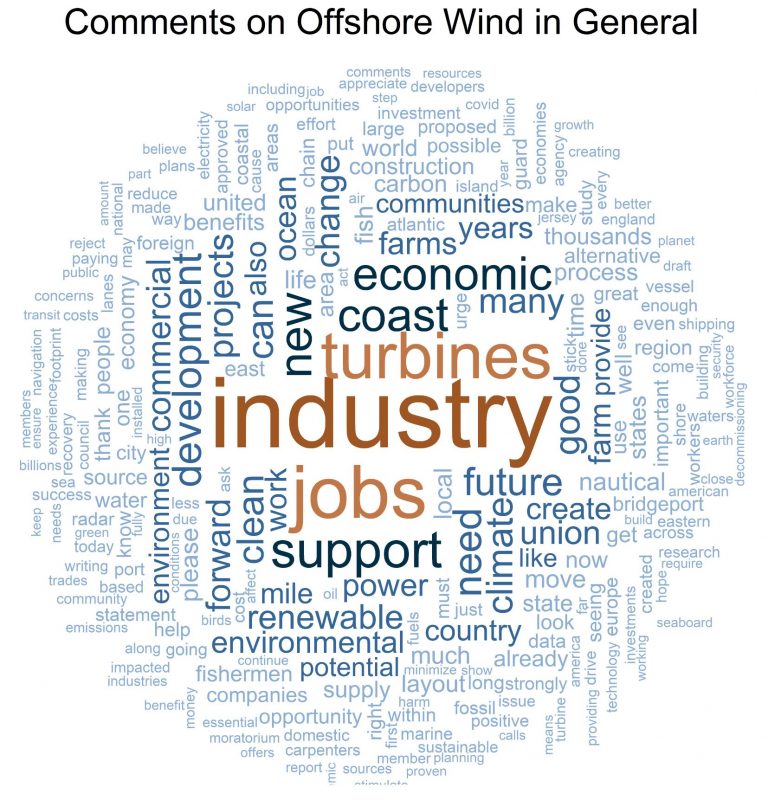ISSUE NO. 25: INSIGHTS FROM PUBLIC COMMENTS ON AN OFFSHORE WIND EIS: PART III
This is the third in a series of notes analyzing public comments on the Supplement to the Draft Environmental Impact Statement recently issued by BOEM for the Vineyard Wind I project. In the first note, we discussed the quantity and type of comments submitted during the public comment period, as well as key themes in the comments and their implications for businesses seeking to develop offshore wind projects in the US. In the second, we more closely examined patterns in comments by comparing comments by those who support, oppose, or do not state opinions on the project. In this note, we discuss themes in the comments, comparing those who specifically discussed the Vineyard Wind I project and those who discussed offshore wind in a more general sense.
Our previous summaries analyzing comments on the Vineyard Wind I EIS reported that many commenters appear to view the public EIS comment period not just as a mechanism for commenting on the EIS document, but also as a forum for expressing their opinions on the proposed project, or even the wider US offshore wind industry. While comments received on Regulations.gov were all submitted in response to the Vineyard Wind I EIS, not all comments actually referenced this project. Many commenters expressed opinions on issues related to the broader offshore wind industry.
We know from deep experience that community perceptions of infrastructure projects do not exist in isolation and are often shaped in large part by wider perceptions of industries, technologies, issues, and impacts. Understanding perceptions of the wider offshore wind industry could offer developers and project proponents insight into baseline perceptions prior to project development, providing an early indication both of drivers of community support and reasons for opposition. Having a clear view of the primary topics to which comments are directed could also help proponents identify and prioritize interested and influential stakeholders for ongoing and/or future engagement activities.
In this final of three summaries, we examine patterns in public comments comparing those that specifically discuss Vineyard Wind I with those that discuss offshore wind in general. (See footer for notes on our methodology)
HOW DO COMMENTS DIFFER BY PROJECT?
(Note: Comments analyzed here are a subset of the 738 unique comments discussed in our previous two notes)
Comments discussing Vineyard Wind:
- 475 comments (64% of unique comments)
- What are their opinions?
- Supportive (70% of comments on Vineyard Wind I)
- Opposed (14%)
- Did not state an opinion (14%)
- Who are they? (70% of these commenters identified themselves)
- People with a local or regional connection (16% of comments on Vineyard Wind I)
- Members of the offshore wind or supporting industries, including infrastructure (14%)
- Others with specialist expertise (13%)
- 37% of commenters on Vineyard Wind I referenced the EIS
- Most-mentioned issues: (Note: Percentages do not add to 100% as most comments mentioned multiple issues)
- Climate change and clean energy (54% of comments on Vineyard Wind I)
- Job opportunities (43%)
- Marine navigation and turbine spacing (37%)
- Commercial fishing (31%)
- Economic benefits (30%)
Comments discussing offshore wind in general:
- 223 comments (30% of unique comments)
- What are their opinions?
- Supportive (63% of comments on OSW in general)
- Opposed (13%)
- Did not state an opinion (22%)
- Who are they? (20% of these commenters identified themselves)
- Members of the offshore wind or supporting industries, including infrastructure (8%)
- All other commenter groups each represented < 5% of commenters on offshore wind in general
- 6% of commenters on offshore wind in general referenced the EIS
- Most-mentioned issues: (Note: Percentages do not add to 100% as most comments mentioned multiple issues)
- Job opportunities (43%)
- Climate change and clean energy (38%)
- Economic benefits (21%)
- Commercial fishing (16%)
- Marine navigation and turbine spacing (15%)
WHAT STOOD OUT/SURPRISED US?
Most commenters on offshore wind in general did not identify themselves – This was surprising as the majority of commenters who specifically discussed Vineyard Wind I identified their connection to the project and/or area of interest. One explanation for this might be that commenters discussing offshore wind in general feel less of a connection to a specific project and/or impacts, and therefore feel less of a need to relate their comments to their specific experience or identity. In other words, people feel more personal connections to specific projects than to an abstract technology or industry. Note: Our observations are based on commenters’ self-descriptions included in the text of their comments (i.e. statements like ‘I’ve been a fishing this area for 20 years’ or ‘My family has lived on Martha’s Vineyard for 3 generations’).
There is not a substantial difference in most-mentioned issues between Vineyard Wind I comments and general offshore wind comments – This was surprising, as we had expected to see more mention of specific, local, project-related impacts in the comments specifically focused on Vineyard Wind I. However, the top five most-mentioned issues were the same for both groups. It is possible that these topics are ones that are emphasized in marketing, communications, educational, and public relations materials aimed at both Vineyard Wind I and the offshore wind industry, and thus are messages that both audiences have absorbed. We discuss this hypothesis in more detail in Part II of this Acorn Note series.
KEY TAKE-AWAYS AND IMPLICATIONS FOR PLANNING FUTURE OSW DEVELOPMENTS
Levels of support and opposition were fairly similar between comments on Vineyard Wind I and OSW in general – This may indicate that stakeholders perceive that impacts and issues related to Vineyard Wind I are consistent with those of offshore wind in general, and therefore do not warrant a specific opinion. This could also indicate that knowledge of a specific project (such as Vineyard Wind I) could shape opinions on offshore wind in general.
Implication: Stakeholders may not draw distinctions between specific projects in deciding whether to support or oppose a development, and thus, the nature of comments on Vineyard Wind I may have a high degree of correlation to what can be expected for future projects. This might provide proponents an opportunity to draw on existing support for offshore wind but could also represent a hurdle to engaging stakeholders who are already opposed to a project.
Commenters who discussed Vineyard Wind I were more likely to mention the EIS than commenters who discussed OSW in general – As the EIS is a key step in the approvals process for Vineyard Wind I, it is not surprising that those who specifically discussed the project were also more likely to discuss its EIS. That commenters who discussed offshore wind in general were less likely to discuss the EIS also supports our hypothesis (discussed in Part I of this series) that many of the stakeholders who submitted public comments view the public comment process as a forum for commentary on an issue of wider public interest as opposed to an opportunity to comment on a specific document related to a specific project.
Implication: Players in the OSW world (developers, regulators, business organizations, NGOs, etc.) should provide outlets and opportunities for stakeholders to share their views through a variety of channels, not limited to regulatory comment periods, to ensure that stakeholder comments are channeled to the most appropriate audience.
Methods: During our review of the comments, we categorized each one as being directed at Vineyard Wind specifically, at another project specifically, or at offshore wind in general (we also used this ‘general’ category for comments where it was not clear at what area there were being directed). We recorded comments as being directed at Vineyard Wind only where this name was used specifically or where it was otherwise explicitly clear that the comment was directed at Vineyard Wind. A small number of commenters were directed at both Vineyard Wind and offshore wind (i.e. comments like ‘I support offshore wind in general but this not this project’), in which case we recorded both opinions. However, comments analyzed in this Acorn Note include only those that discuss Vineyard Wind OR offshore wind in general (not comments that discuss both). Due to the very low number of commenters that only discussed another specific project (n=3, discussing a project offshore Ocean City, MD), we do not analyze those comments here.
News & Notes

Acorn International
1702 Taylor St, Suite 200B
Houston, TX 77007, USA
1213 Purchase St
New Bedford, MA 02740, USA
